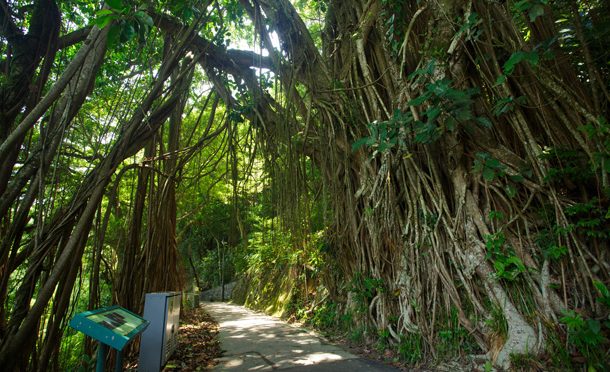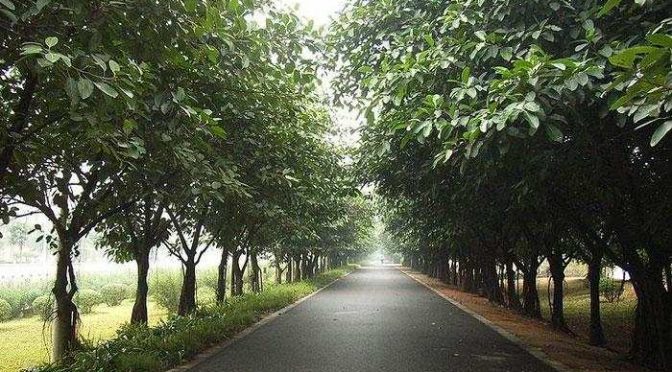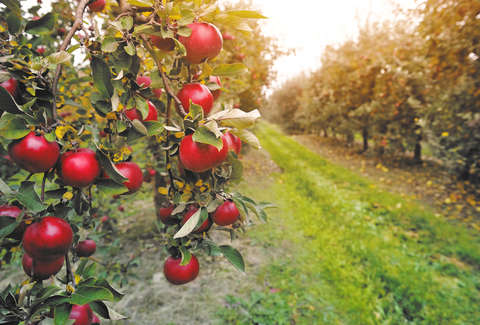Category Archives: Environmental Trail

Genus Ficus
Ficus is a genus of about 800 species of trees, shrubs, scrambling climbers, creepers, and epiphytes which are native to the tropics and subtropics. They are collectively known as fig trees. Ficus is by far the largest genus in the family Moraceae and one of the largest genera of flowering plants. Some of the best-known figs include Ficus religiosa, the sacred fig which is of religious significance in Buddhism; Ficus carica, the common fig which produces multiple fruits that are commercially important; Ficus benghalensis, the…

Bodhi Fig Tree Lane
Religious Significance Ficus religiosa, commonly known as Bodhi tree or peepal tree, is a species of fig that belongs to the fig or mulberry family Moraceae. It is also known as sacred fig as it is considered sacred in Hinduism, Jainism and Buddhism. Gautama Buddha is said to have attained enlightenment while meditating underneath a sacred fig. The tree is located in present-day Bodh Gaya, Bihar, India which is one of the most important four main Buddhist pilgrimage sites. In India, the sacred figs are…

Community Roadside Trees
Suitable roadside trees in healthy condition and properly cared for can make our city cleaner, greener and have a direct impact on our community through various benefits they provide. Apart from the aesthetic and recreational benefits that roadside trees bring by beautifying the city and providing green spaces, public health is also enhanced as roadside trees can remove dust and absorb harmful gases, improving the air quality and making the city more livable. Roadside trees can prevent soil erosion, lower ambient temperature through cooling effect…

Paper-Bark Tree Walk
Melaleuca cajuputi, commonly known as Paper-bark Tree, is in the family Myrtaceae and can grow up to 20m tall. Its genus, Melaleuca, has a meaning of black and white, referencing to the whitebark which is often charred by fire. The common name, paper-bark tree, also stems from the distinctive appearance of the trunk which is covered by whitish papery bark peeling off in thin layers. Native to Australia, this feature helps the plant to survive a forest fire. When a fire burns through paper-bark tree…

Succulents and Cacti
Succulent plants refers to a broad, loose category of plants, including cacti, which have developed thick fleshy leaves or stems. These serve as water storage organs to insure survival under arid conditions. Succulents are found worldwide. Besides cacti, they include many familiar plants: jade plant (Crassula arborescens)snake plant (Sansevieria trifasciata)medicine plant (Aloe barbadensis)century plant (Agave americana)flowering Kalanchoes (Kalanchoe blossfeldiana) and the sedums (Sedum sp.), both sold as gift plantshens and chicks (Sempervivum sp.), common in the perennial garden Cacti characteristics The cactus family has nearly 2,000 species,…

Greenhouse
A greenhouse is a building with glass walls and a glass roof. Greenhouses are used to grow plants, such as tomatoes and tropical flowers. A greenhouse stays warm inside, even during the winter. In the daytime, sunlight shines into the greenhouse and warms the plants and air inside. The darker the surface, the more heat is generated. The greenhouse panels are good at transmitting light, but not heat. Greenhouses take the suns energy and heat and trap them in the greenhouse. This helps create massive amounts of heat relative to the outside and…

Role of Fruits in Evolution
Next time you bite into a slice of watermelon or a cob of corn, consider this: these familiar fruits and veggies didn’t always look and taste this way. Genetically modified foods, or GMOs, inspire strong reactions nowadays, but humans have been tweaking the genetics of our favourite produce for millennia. While GMOs may involve splicing genes from other organisms (such as bacteria) to give plants desired traits – like resistance to pests, selective breeding is a slower process whereby farmers select and grow crops with…

Orchard
The Types of Orchards The United States Geological Survey defines an orchard as any non-natural wooded area where trees are planted for the production of fruits, nuts or seeds. Orchard owners often concentrate on a particular species or product, resulting in hundreds of different types of orchards. If you dream of starting or buying an orchard, it’s helpful to understand the different types available and then match these options to local climate, your budget and your interests. Fruit Orchards Fruit orchards include any facility focused…

Evolution of Angiosperms
Evolution of Angiosperms Undisputed fossil records place the massive appearance and diversification of angiosperms in the middle to late Mesozoic era. Angiosperms (“seed in a vessel”) produce a flower containing male and/or female reproductive structures. Fossil evidence indicates that flowering plants first appeared in the Lower Cretaceous, about 125 million years ago, and were rapidly diversifying by the Middle Cretaceous, about 100 million years ago. Earlier traces of angiosperms are scarce. Fossilized pollen recovered from Jurassic geological material has been attributed to angiosperms. A few…